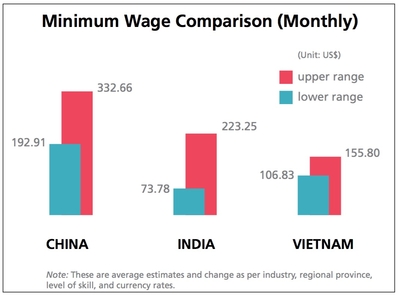 The minimum wage refers to the minimum amount of compensation paid to an employee in return for labor services. This amount is legally fixed by contract or by government legislation. Most countries in the world have laws in place that regulate the minimum wage. Establishing a minimum wage provides assurance that employees will be protected from exploitation and paid according to their labor performance. Because standards of living and other economic conditions vary widely, the minimum wage differs across countries as well as in different jobs, industries, and regions within each country.
The minimum wage refers to the minimum amount of compensation paid to an employee in return for labor services. This amount is legally fixed by contract or by government legislation. Most countries in the world have laws in place that regulate the minimum wage. Establishing a minimum wage provides assurance that employees will be protected from exploitation and paid according to their labor performance. Because standards of living and other economic conditions vary widely, the minimum wage differs across countries as well as in different jobs, industries, and regions within each country.
Economists tend to criticize the minimum wage compensation as it creates a virtual price floor on salaries that could produce inefficiencies. Also, a higher minimum wage deters companies from hiring more, thereby increasing unemployment. On the other hand, a decent minimum wage ensures that employees receive fair compensation, allowing them to afford the basic necessities of life. This in turn incentivizes efficiency on the job, particularly in competitive labor markets.
Such debates have taken center stage in China, India, and Vietnam as they compete to offer the most attractive markets for manufacturing and foreign investments. As it stands, China, the manufacturing hub of the world, has the highest minimum wage relative to Vietnam and India, while India’s is the lowest. Vietnam offers a competitive labor landscape in the region, even as it allows for an annual increase in its minimum wages.
In the following sections, we examine how the three countries have respectively tried to reconcile the underlying dilemma of creating a cheap labor market while also raising wage levels to promote domestic consumption and better standards of living.
China’s Wage Levels
China, long considered the manufacturing hub of the world, has experienced rising labor costs in recent years that have pushed companies to either downsize staff or consider relocating to cheaper labor markets. The country’s 12th Five-Year Plan (2011-2015) drove labor costs up with a projected 13% annual increase in the minimum wage. Since then, China has had to somewhat backtrack to retain its favorable factory set-up. Toward this, the 13th Five-Year Plan (2016-2020) introduces a controlled mechanism for wage adjustment to lessen the wage difference with other developing countries. Additionally, the wage revision cycle is now extended and is no longer every two years.
Minimum wages are determined and adjusted at the provincial level in China. Factors considered include economic development, local employment conditions, minimum cost of living and consumption price index in the area, individual costs associated with social insurance and housing costs, and enterprises’ average response to labor costs.
Accordingly, different regions have different wage levels, and provincial governments have sought to reduce the pressure on poorly performing businesses. For example, a directive by the Guangdong provincial government states that for businesses with relatively better performance, wages will rise by 8.5% but no more than 12.5%. Further, the Guangdong government will maintain the 2015 minimum wage level for both 2016 and 2017. Similarly, other Chinese provinces also have agreed to freeze the minimum wage for at least two years. Most notably, the three provinces in China’s northeast rust belt— Heilongjiang, Liaoning, and Jilin—have not witnessed a wage rise since 2013.
Overall, economists predict that China’s wage growth will increase only by 6.5% to 6.9% in 2016, lower than that seen in 2015 at 7.4%.
 India’s Wage Levels
India’s Wage Levels
The Minimum Wages Act, 1948 lays down the legal provision for fixation and enforcement of the minimum wage in certain “scheduled” employments in India for both skilled and unskilled labor. The Act is legally non-binding but statutory, and payment of wages below the minimum wage rate is considered forced labor.
The policy for minimum wage determination in the country aims to prevent human exploitation, protect workers in sweating employments, and promote fair wage agreements in the organized industries (via negotiated labor contracts and settlements). The minimum wage law is also the main labor legislation applying to informal sector workers, which include contract labor, construction workers, casual labor, workers in micro enterprises such as small handloom units, tanneries, etc., sweepers and scavengers, employees in shops, and workers in agriculture.
In order to effectively enforce the Minimum Wages Act, the government has established Wage Boards to review an industry’s capacity before fixing its prevailing minimum wage rate. The minimum wage thus calculated should afford workers the basic requirements of calorie intake, shelter, clothing, education, medical assistance, and entertainment.
In India, minimum wage rates in the organized sector differ across states, industries, skill levels, regions, and occupations owing to the significant difference in costs of living, industries’ capacity to pay, and regional consumption patterns. Thus, there is no single uniform minimum wage rate across the country and the structure is extremely complex. Scope for effective regulation in the much larger unorganized sector (over 85% of the economy) is also deeply compromised, often resulting in labor getting paid below the minimum wage.
Since July 1, 2015, the National Floor Level of Minimum Wage has been fixed at around US$ 2.38 (Rs 160) per day. Yet, this wage rate is only applicable to specific occupations in specific industries, which are termed as “scheduled employments.” Currently, the number of scheduled employments under the central government is 45, whereas in the states sphere, the number is 1,650. It must be noted that as respective state governments are empowered to independently fix minimum wages, disparities between wages in neighboring states are conspicuous.
A proposal to raise the minimum wage in the country by 25% was recently put on hold. It would have raised costs for manufacturers, compounding the impact of the current global economic headwinds.
Vietnam’s Wage Levels
New minimum wage rates have been implemented in Vietnam since January 1, 2016, showing an increase of about 12.4% on the year. This has put the new minimum wage at US$ 11.1-17.8 (VND 250,000-400,000) higher per month than in 2015. Though the wage increase for 2016 has not been as high as in previous years (17.5% in 2013 and 15% in 2014), it will be even less in 2017 if the National Wage Council’s latest proposal is approved by government.
At a hike of 7.3%, Vietnam plans for a minimum wage increase of about US$ 8.07 to US$ 11.21, depending on the area, in 2017. This is a conscious decision as the limited hike tries to reconcile the concerns of both workers and employers. Additionally, Vietnam wants to maintain its edge as a competitive manufacturing destination despite the emerging cheaper alternatives in Cambodia and Bangladesh.
Minimum wage determination in Vietnam follows a four-tiered system that is adjusted and administered via regional zones. Zone 1 has the highest minimum wage, while Zone 4 has the lowest.
The monthly minimum wage in the four zonal divisions for 2016 is noted below:
- Zone 1, which covers the urban areas of Hanoi and Ho Chi Minh City–VND 3.5 million (US$ 155.8)
- Zone 2, which covers the rural areas of Hanoi and Ho Chi Minh City, and the urban regions of Can Tho City, Da Nang City and Hai Phong City–VND 3.1 million (US$ 137.99)
- Zone 3, which consists of the provincial cities and the districts of Bac Ninh Province, Bac Giang Province, Hai Duong Province, and Vinh Phuc Province–VND 2.7 million (US$ 120.2)
- Zone 4, which consists of the remaining localities, including the least developed parts of Vietnam–VND 2.4 million (US$ 106.83)

On average, Vietnam is still seen as a wage-competitive market in the region, especially when compared to neighboring countries. The current monthly minimum wage in Vietnam is US$ 106.83-155.80, while Cambodia’s is US$ 121.90. China’s minimum wage rate ranges from US$ 192.91-332.66, and Thailand’s is around US$ 265.68.
Observations: When comparing their minimum wage policies, it becomes apparent that initial wage gains have been put on hold in China to combat much cheaper labor costs in Vietnam and India. India, too, recently shelved its decision to raise the minimum wage by 25%, to ensure companies based in the country remained competitive (see Figure 1). Meanwhile, Vietnam has safely priced itself in the labor market while at the same time ensuring annual wage hikes. As a result, it has come to be one among the preferred alternative destinations for China-based companies looking to geographically de-risk/diversify their operations because of rising input costs.